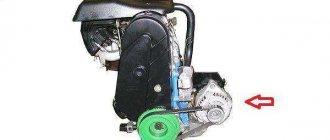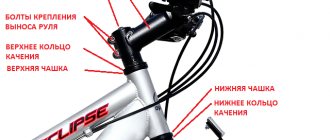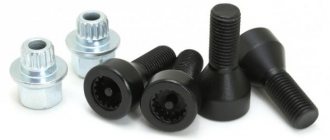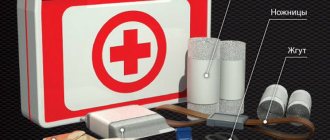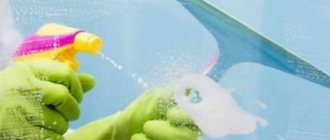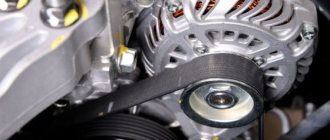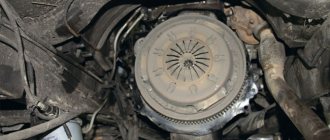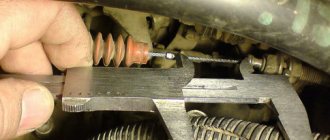Design features of the hub nut
The hub nut is located in a unit whose operation occurs under conditions of high temperatures, mechanical and external influences. Therefore, alloy steel with anti-corrosion coating is used for manufacturing. The part, in addition to the standard nut elements, has grooves. After reaching the required torque, a locking pin is inserted into them or mechanically fixed with a chisel. The outside of the nut is surrounded by 6 standard edges. We gain access to the locknut after removing the protective cap.
Which way do the hub nuts unscrew?
When making repairs, car owners without experience have a question: “In which direction can the part be unscrewed in the easiest way?” Of course, it all depends on the brand of car, for example, in Chinese, the design and direction of the thread may differ, but there are two basic rules:
- On older car models, where fixation with a cotter pin and groove is not provided, we try counterclockwise on the left wheel, and clockwise on the right wheel.
- On modern machines this problem does not exist; the lever must be applied counterclockwise, regardless of the place of work. The pressure will be high, so it is necessary to use a stopper.
Video on removing a pulley on cars from various manufacturers
Now let's talk about specific brands and a method that can solve the problem of removing parts.
VAZ car
In this video, auto mechanics managed to unscrew the bolt without any problems, but the pulley itself could not be removed and had to drill holes. We recommend that everyone use this method.
Ford car
Here an expert talks about the difficulties with the damper option. Pays attention to working with the puller.
Renault car
A car mechanic shares the intricacies of fixing the crankshaft. Uses an 18 mm wrench and an old screwdriver.
Honda car
The recording talks about the shaft rotating in the opposite direction: not like most cars. The author also shows us a homemade device for work.
How to unscrew the hub nut - the main 5 methods
To solve the problem of how to unscrew the hub nut, it is necessary to determine the dismantling method. This can be done in one of two main ways:
- With the wheel removed.
- The car is on wheels.
If the nut does not unscrew, we make a choice taking into account the following possible methods:
| Name | Description | What tools are needed? | When to use |
| "Barbarian" option | Provides for dismantling and subsequent replacement. | Drill with metal drills (of different diameters), chisel, hammer (small sledgehammer). | It is used if there is no chance to unscrew it in the usual way. |
| "Hot" method | Heating the metal at the joint. | Burner. | Bearings and hubs must be replaced. |
| "Delicate" work | Carefully unscrew the stuck part, gradually increasing the force with the lever while simultaneously tapping on the body. | Tubular socket wrench, heavy-duty screwdriver, hammer, extension pipe, deep penetration lubricant. | If necessary, perform the work as carefully as possible |
| Maximum force | A powerful wrench and a long pipe can significantly increase the force, thereby increasing the chances of stripping the thread. | Heavy duty socket wrench, long pipe. Heads for licked nuts. Key with hydraulic or electric drive. | A strongly stuck nut. |
| Using chemicals | A soaked rag will gradually relieve the problem. | Kerosene and (or) white spirit, hammer, rags. | If you have time. |
You can quickly unscrew a stuck element if you provide a lever. It is installed on the ratchet wrench using a small pry bar. You can use a piece of pipe of suitable diameter with a length of at least 1 meter.
The bolt is stuck: how to unscrew it?
Repair is difficult, replacement of spare parts is complicated by metal corrosion or hydrated iron hydroxide for a trivial reason. For example, during installation at the factory or previous repairs, unscrupulous craftsmen ignored treatment with lubricants (Movil or grease). As a result of operation, water got under the threads. It caused the surface of the bolt and nut to loosen, locking them tightly together with a new molecular compound. Each car enthusiast will choose a suitable method for working with a stuck bolt or use a combination of the methods proposed in this article. Therefore, let's look at some of them.
How to unscrew a nut from a hub - Standard method
If the hub fastener was installed correctly and the car was regularly serviced, there will be no problems with dismantling work. If they are “tightly” stuck to each other, you will need to apply quite a lot of pressure. As a rule, a special head (with an additional hole), a ratchet wrench, and a pipe at least 1 meter long (as a lever) are used. But how to unscrew it if the connection did not yield to a standard wrench and the effort of one person.
Operating procedure:
- Place the car on a level surface and securely lock the wheels.
- We open the protective cap and carefully remove the cotter pin from the lock nut, if there is one, or simply unlock it.
Classic methods
Essentially, standard dismantling methods involve two main methods.
You will need:
- jack to remove the wheel
- tool kit
- hydraulic jack to lift the engine, or replacing it with a “stump”
First way
In the first case, we will have to make significant physical efforts, therefore, you need to clearly focus on your own strength. We are talking about the need to put stones or special stops under the wheels that would not allow them to move during operation. The gearbox should, if possible, be set to maximum gear. The higher it is, the easier it will be for you to cope with the task. In third and lower gears, it will be almost impossible to make a turn with your hands. But everything is unscrewed by hand. To make this task easier for yourself, it is appropriate to use a lever that will reduce the necessary effort. In some cases, the length of the lever can reach one and a half meters.
Getting to the bolt is not always easy
Second way
As for the second method, it involves placing the vehicle in neutral gear. Next, you need to install a suitable sized head on the bolt with a piece of pipe, which, in turn, rests on asphalt or concrete. Ordinary soil will not be able to hold it. But the bolt itself is already loosened by the starter.
This saves a lot of effort and makes it possible to complete the task the first time. The main thing is to take into account the reliable fixation of the pipe so that it does not jump out and damage anything around it.
Be careful not to lose the pulley key
If the nut on a VAZ does not unscrew, we use “power options” for dismantling
During prolonged use, the part may become firmly stuck at the thread. In this case, it will be necessary to apply a fairly large force with a varying load. We suggest the following procedure:
- Purchase a pre-reinforced head (there should be an additional hole and more edges inside it).
- We install the knob on the head.
- We connect the pry bar, the handle of the key, to a long pipe with thick walls.
- Apply force to the lever.
- At the same time, tap with a hammer to destroy the formed rust and separate the part from the hub.
- Gradually increase the pressure. We use the muscle power of 2 people.
How to remove a hub nut from a thread - radical methods for VAZ owners
Sometimes power options are not enough, this is especially observed on cars of the VAZ family, where bearings are often adjusted. In this case, auto mechanics advise switching to radically aggressive dismantling methods:
- Break the fasteners with a chisel, hammer or nut splitter/nut splitter;
- A series of holes are drilled along the groove for locking;
- Heat the connection with a gas burner;
- Solve the issue by welding (welding a similar nut or a larger one).
If the nut is stuck to the shaft, unscrew it using chemicals.
A fairly effective and efficient method is to apply chemicals to neutralize the resulting rust. Experts advise making a mixture of kerosene and white spirit. Then you need to moisten cotton or gauze material in the solution and apply it tightly to the permanent connection.
It is advisable to cover it with a bag or secure it with plasticine so that the solution does not erode. You need to wait at least an hour. If you have time, leave it overnight. Then, using the usual method, we try to unscrew the fasteners. Light tapping on the base is allowed (be careful not to break the thread).
A more effective solution for removing rust is a mixture of sulfuric acid, water and zinc.
We remove and repair
The carriage can be integrated or non-integrated. The latter, according to the type of device, are divided into cartridge (axle, cups, connecting rods - a single system) and collapsible (parts can be unscrewed so that they can be repaired and cleaned). Typically, the carriages of a touring bike or an average mountain bike are designed in a standard way, so they can be repaired according to a proven pattern.
To make it more convenient, it is better to turn the bike upside down and place it on the handlebars.
Once you are sure that the bike is level and solid, you can proceed to repairs:
- Carefully remove the left and then the right connecting rod from the axle.
- We thoroughly wash the carriage assembly and remove old dirt that has accumulated behind the connecting rods. We carefully clean the slots in each cup - if they are clogged, it will not be possible to install the puller.
- Let's start removing the carriage itself. We start on the left (where there are no stars). If your bike has a locking nut, carefully unscrew it with a wrench (you can use a wrench). Nuts of this type usually have right-hand threads, so you will have to apply some force, but try to tighten the nut carefully so as not to rip off the key.
- After that, take a slotted key or a special key for the carriage. As soon as it fits into the grooves, immediately unscrew the cup with an adjustable wrench with a long handle. If your carriage is collapsible, the cup must be removed along with the bearing.
- On the right side (where the asterisks are) we perform similar actions using the same long key. The carving on the cup, accordingly, is no longer right-handed, but left-handed, so effort will be required.
- Next, you need to remove the right cup with the axle or the cartridge (depending on the type of carriage).
- If you have a collapsible design, remove the bearings from the removed carriage. We carefully clean the places where the old lubricant remains. We wash all parts in kerosene or any other solvent.
After the carriage is cleaned and the parts are dry, install in the reverse order.
Possible problems for VAZ owners and not only
With long-term exposure to tools and repeated attempts to remove the nut, “force majeure” situations occur, which include:
- the edges are licked off;
- wear of the union head;
- does not withstand the ratchet mechanism;
- the thread on the shaft or locknut is knocked out;
- violation of adjustment, tightening torque;
- the bearing is damaged.
We buy a spare locknut and cotter pin in advance. It is also advisable to have a spare set of special keys before dismantling.
It is not recommended to unscrew
Don’t try to “discover America” again; the methods listed above will help break the locknut in 99% of cases. The following methods should not be attempted:
- Cut using argon, oxygen or electric welding;
- Strong blows with a hammer or sledgehammer on the end surface;
- Jumping on a lever;
- Impacts on the side, edges, base;
- Exposure of the part to open flame (for example, pour kerosene on it and set it on fire).
Further sequence of actions
So, the hub nut was successfully unscrewed. What to do next?
- First of all, an external inspection is carried out to determine the integrity of the threaded elements. Using fine sandpaper, improvised materials, kerosene or solvent, the entire surface of the thread on the stud is thoroughly cleaned to bare metal. Order factory hub nuts in advance.
- The tightening is carried out under load control. We use a torque wrench.
- To prevent this part and contact from sticking again, we use a special deep penetration lubricant WD-40 or thick graphite lubricant.
- Don't forget to lock or install a cotter pin.
Security measures
To safely unscrew the hub nut, the following requirements must be met:
- Use proper tools and accessories;
- Firmly fix the body in its original position (handbrake, heel);
- Use special anti-slip gloves;
- If excessive force is used, do not place body parts under the car body if the wheel is jacked up;
- First we try to unscrew it using more gentle methods, trying to preserve the original locknut;
- The sequence of actions is defined in the operational map. It must be followed.
Which way does the hub nut unscrew?
Yes, you may very well be one of the lucky ones who won't need any extra effort as the problem with unscrewing the hub nut may simply be a matter of going in the wrong direction.
So, we take the wrench and, when your car is far from new, try, if the nut does not lock, on the left wheel, unscrew the nut counterclockwise, and on the right wheel, unscrew it clockwise. In modern brands, it is usually necessary to unscrew the hub counterclockwise .
Before you start unscrewing the hub nut, do not forget that it comes off when the car is standing on the wheels and the stops are placed under them. On the side from which the nut will be unscrewed, a stop is securely installed.
Although if the nut is located deep and the brake disc is ventilated, then you can try to unscrew it (fixing it with a powerful screwdriver) and only after making sure that the car is securely secured. Remember about personal safety precautions: protect your eyes, do not overdo it, because in the spirit of enthusiasm you can accidentally get hurt or damage the car body.
Unfortunately, in most cases, it is not enough to use a wrench with a large lever; you have to use additional tools and special mixtures. Let's consider the other options.
How to Unscrew a Broken Bolt or Screw
A broken bolt or screw has to be drilled out, how to do this correctly so as not to damage the thread?
First, file down the fracture site with a file or at least a large needle file to facilitate core punching. Try to mark exactly in the center and well. Drill the bolt, the drill diameter should be approximately 0.8 of the thread diameter, for example M8 thread - 6.4 mm drill. A more accurate table of thread hole diameters. Large bolts are first drilled with a small drill. For steel bolts, choose low drill speeds and use oil, it will work better and the drill will be alive.
Remove the remaining bolt and tap the threads.
It often happens when a thread is torn off, it’s good if it’s on a bolt, it’s easier to replace it with another one, worse when it’s in a part. If several turns are torn off or the thread is wrinkled, try going through it with a tap. But if there’s nowhere to cut it, then you’ll have to cut more threads. If the wall thickness allows, we cut a new one. To do this, we drill a hole to the next diameter, for example there was an M6, it was torn off, the next one is M7 or M8 (M8 is more common), we drill it carefully with oil.
Now we cut a new thread.
First, use a tap with number 1, slowly turning it half a turn periodically to clean it from chips; if the hole is deep and blind, then turn it out to the end. After cutting, we blow through the hole and the tap, and cut with the second number, just like the first. There are also universal taps that replace numbers 1 and 2. Do it carefully, lubricate it often and turn it back out so as not to break it.
When assembling parts, wash all bolts and nuts in gasoline or acetone. Lubricate the threads with oil or grease. In units that operate at high temperatures, it is better to lubricate the threads with graphite lubricant, but in no case with oil or grease, otherwise you will not be able to turn it later, the oil and grease will simply coke.
PS: Which way to unscrew the bolt?
. It's strange but many people don't know. Regular bolts and nuts are unscrewed counterclockwise and tightened clockwise.
Among detachable connections, threaded ones take first place both in terms of prevalence and reliability. However, in practice there are many cases when it is not easy to unscrew a threaded pair.
The easiest way to unscrew/tear off a hub nut
The easiest way can be considered the following, but it involves completely replacing the nut. Don't worry, any method does not guarantee the safety of this part. To easily unscrew or tear the hub nut out of place (an option for all brands - from VAZ to foreign cars with a groove on the shaft), you need to take:
Unscrewing the VAZ hub nut using a drill
- New nut.
- Drill or screwdriver.
- Drill up to 3 mm.
- Chisel.
- Hammer.
- You need to drill the nut along the groove to counteract it.
- Using a chisel and hammer, simply break the nut and remove it, then replace it.
- If throwing away the nut is not possible, then you will have to sweat - and in the literal sense of the word too.
Adjusting the bearings
The cause of extraneous noise, play and unpleasant rattling in the rear wheel carriage is often loose bearings. This can damage them, cause the cups to become deformed, or interfere with smooth shifting. If any suspicious symptoms occur, you need to think about how to tighten the carriage on your bicycle. In this case, it is better not to postpone the adjustment. If you have the skills, you will be able to tighten the carriage even during a trip, bypassing the disassembly stage.
- To begin work, remove the left connecting rod from the rear carriage and unscrew the lock nut with a special wrench. Then, using a slotted wrench, slightly loosen the left cup.
- Screw the left cup almost all the way. If you wrap it loosely or too tightly, the axle will begin to play or jam. To avoid the latter, loosen the cup a little (about ¼ turn) with a long wrench.
- After that, screw the locking nut on top and tighten it until it stops with the same wrench that was used to unscrew it.
- Let's check how the carriage axis works. To do this, we twist it by hand, then rock it back and forth from side to side. Even a small lift or barely perceptible jam is a good reason to repeat the adjustment from the beginning.
How to unscrew a hub nut - the delicate way
- Tubular socket wrench - “wrench”. The tool must be made of high-strength steel.
- Powerful screwdriver.
- Iron pipe.
- WD-40.
- Wire brush.
- Clean the threads from dirt using a brush with metal bristles. Now you should soak the hub nut with penetrating lubricant. For example, WD-40.
- We impregnate the hub with the penetrating mixture. You can rest for 10-15 minutes, and then you should put the wrench head on the nut and hit it with a hammer several times, gradually increasing the force of the blow. Just don’t overdo it: the point of this action is to slightly deform the nut, which will make it easier to remove. And immediately after the impacts, you should try to unscrew the hub nut on a VAZ or a car of another brand.
Remove the nut from the car: force method
- Lever made of pipe (length of at least one and a half meters).
- Powerful socket wrench (450 mm).
- Head of the appropriate size.
Place the head of the wrench on the hub nut, insert the wrench and place the pipe on the handle. Gradually increasing the applied effort, we unscrew the part.
As experienced car enthusiasts say, few hub nuts can resist for a long time if you use a Zilov cylinder!
How to unscrew a broken bolt
What to do, what to use and how to unscrew it if a pin or bolt is torn off. Video tips on how to independently unscrew a broken bolt/stud in an engine or manifold. A reliable way to unscrew if the head of a bolt has been torn off Read more
Using solvents
There are no hopeless situations. It’s too early to take on a cutting tool until you know what to do if a bolt gets stuck. Any car enthusiast has several liquids in his arsenal that have the ability to fight rust. The first product in the line of solvents that most likely comes to mind is WD-40. This is an aerosol that is capable of penetrating its components into micro-gaps and dissolving rust. If this option is not available, then in almost every garage there are such products as antifreeze, brake fluid, white spirit, kerosene, Coca-Cola, and in extreme cases you can take ethylene glycol. You need to be very careful with the last substance. Protect the mucous membrane of the eyes and respiratory tract.
Moisten the nut with the selected liquid by wrapping it with a rag previously soaked in the same solution. Then it is necessary to leave all this for some time for the substance to penetrate into microcracks. Next, by tapping the bolt or nut, you can destroy the softened rust. After this you can start unscrewing. It is worth noting that if a bolt or stud is screwed into the housing vertically (even if it is down and filled with solvent), it is not so easy to unscrew them. But still, you should not underestimate the capillary capacity of liquids, especially in the loose environment of rust. All you have to do is find a way to secure the rag to the stud or bolt head. And also follow the already proposed path.
When repairing the chassis of a car, you can often encounter a problem when a bolt on the strut has become stuck. What to do? Basically, the lower part of the front pillars is mounted in a glass. Therefore, the solvent can be poured directly into it. It is important here not to damage the rubber bands on the stands, since the chemistry can react with them and dissolve them. Then you will have to change the racks too.
Unscrewing the hub nut on a VAZ: “burn, hit and twist!”
Now let’s look at the methods that may be the only effective ones in your case, but that doesn’t make them any less radical, even barbaric.
Strong hammer blows
If you hit the hub, you hit the bearing! If you are going to make a replacement, then go ahead! If you value the bearing, avoid this method.
Warming up the hub nut with a burner. Not recommended!
Using the burner
The law of physics is guaranteed to work, and the body (read: hub nut) will expand. And this will make it much easier to remove the stubborn part. There is one “but”: not only this one part heats up, but also everything else in the area of the burner. For example, a bearing. And it’s better not to allow this. As a more gentle option, we can suggest using a soldering iron and... patience. You'll need it.
Jumping on a lever
A chisel will help you remove the hub nut.
The “method” is fraught with the danger of unexpectedly breaking off the edges of the nut, breaking the key, and so on. Just don't do it.
Take a chisel and make notches on the edges
An increase in diameter, of course, makes the hub nut unsuitable for further use, but it will be easy to unscrew it.
Chemical
Now we will consider methods for those who do not rely on the help of physics, but want to solve the problem with the help of chemistry. Your laboratory should have: kerosene, white spirit, acidified sulfuric acid, zinc, plasticine, hammer, water, sandpaper, wrench, chisel.
Attributes of the chemical method for unscrewing the nut
We moisten the nut and bolt with kerosene (experienced people recommend making a mixture of White Spirit and kerosene), applying a swab to them, it doesn’t matter whether it’s cotton or gauze. After some time - from an hour to a day, and with repeated attempts, you may find that the hub nut can be easily unscrewed. But even here you cannot do without force: at a minimum, you will probably have to work with sandpaper to clean the parts from rust. If even after this things don’t work, you should help with a hammer: tap it on the edges of the hub nut.
If in this case you are not successful, make a small container out of plasticine, secure the hub nut on top, pour water with sulfuric acid into it, and put zinc in the container. A chemical reaction begins that does a very good job of removing rust. Usually a day is enough for even advanced corrosion to go away from a part. Finish the job with a wrench. But this method is valid only in the case when the reason is that the nut is tightly stuck and/or rusted, and if it was simply tightened, neglecting the required tightening torque (to “be sure”), then you just need to tighten it.
What is the result..
As you can see, unscrewing the hub nut is not an easy task, but it can be solved. Please note that the first step is to try to preserve the hub nut by using penetrating fluids such as Vedeshka. Physical efforts to twist the hub should be moderate. And, of course, you should refrain from strong blows and heating with a torch, as methods that can render not only the nut, but also the bearing unusable.
Video.
Boris DAKHNOVSKY
Lever torque wrench. Simple, cheap, reliable and quite accurate.
Well, the renovation is entering its final stage - it’s time to start assembling. How do you usually tighten nuts and bolts? "From the heart"! One will pull it up, and then also rest its foot on something - to “tightly”. Another will put a pipe on the key, and also insert a crowbar into it...
In fact, all fasteners are designed to be tightened with a strictly defined force - in engineering it is called torque. Not less than necessary (otherwise it will actually come loose), but not more (you’ll break the thread)… But where is this golden mean? A torque wrench will tell you - it will measure and show you the magnitude of the torque-force. And those keys that are the most modern will also “tell you” out loud when it’s enough.
The oldest torque wrenches have a circular scale and a clock-like mechanism. In them, when a bolt or nut is tightened, a thick steel rod is twisted, and only slightly. A gear reducer multiplies this tiny movement, and the dial pointer rotates enough to allow a mechanic to judge the force being applied to the fastener. This device is not particularly accurate, especially not a new one: as the mechanism wears out, the gaps in the gears and their axes cause play in the pointer, and sometimes even jamming.
Later they came up with a simpler tool. A rod of strictly defined rigidity and length is attached to the base of the square key (for a hex head). And at the other end there is a handle with a scale.
An arrow is also attached to the square. When the mechanic tightens the nut, the rod bends, and the arrow, always stationary relative to the square, shows the force on a scale that has shifted along with the end of the rod. This is a very simple and cheap tool. And if the manufacturer has accurately followed the manufacturing technology, then it is the most reliable. The rod may become deformed from old age—the needle, when free, will not point to zero. To restore the accuracy of the device, bend the arrow - it is made of mild steel.
The most modern, sophisticated torque wrenches are more likely to be used in specialized workshops or on a factory assembly line. They have a scale that vaguely resembles a micrometer scale, and by following it, you can very accurately set the required force. When it is reached, a loud click will be heard and the hand will feel a recoil. So, you're done with this nut - it's time to move on to the next one. Such a tool is very convenient if, for example, you need to tighten the crankcase halves - tighten 20-25 bolts with the same force. For less monotonous work, adjusting the device to “your own” force for each nut is tedious - here it is more convenient to use a simpler tool.
Micrometer scale
How hard to tighten the fasteners - this can be found in the repair instructions. Do not rely on your own experience and do not try to use “other people’s” documentation. Even on motorcycles of similar design, fasteners for identical components should be tightened with different torques (see Table 2). It may differ several times! If you suddenly do not find any recommendations, it means that the nut or bolt is standard, and they need to be tightened with a standardized force (see Table 1).
For complex parts held together by many bolts, the instructions provide a diagram showing the tightening sequence. If you do not follow it, the entire assembly can become warped, a leak may form, or a shaft may jam. Are there several bolts, and the sequence of their fastening is not indicated? This means they need to be tightened crosswise. And gradually, in several stages, until the torque wrench shows the desired torque.
| General Torque Specifications for Standard Fasteners | ||||
| Turnkey size, mm | Thread diameter, mm | Torque | ||
| lb*in | ||||
Modern torque wrench
When reading the torque chart, pay attention to the notes. They may stipulate special assembly conditions. For example, that the thread should be lubricated with oil or thread sealant before tightening... If there are no additional requirements, then it is assumed that the fastener parts must be clean and dry. And preferably neither very chilled nor hot - at room temperature.
| Tightening torques for bolts and nuts securing cylinder heads of various motorcycles | |
| Motorcycle model | Tightening torque, kgm |
| Honda CBR250 (bolts) | |
| Honda CBR600F 89-90 | |
| Yamaha DragStar 1100 | |
| Yamaha Fazer FZS600 '98 | |
| Yamaha TDM 850 99 | |
| Kawasaki ZZ-R1100 93-01 | |
| Kawasaki Ninja ZX-6R | |
| Suzuki GSX-R1100 86-88 | |
Source of material: MOTO magazine
If you opened this article, it means that the strong words are behind you, you pulled yourself together and decided to find answers to the questions: “What to do if a bolt is stuck? How can I unscrew it? Let's try to figure out this problem.

